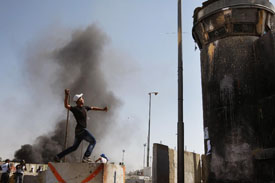JERUSALEM -- The population of Jewish settlers in the occupied West Bank has continued to surge during Prime Minister Benjamin Netanyahu's years in office, growing at more than twice the pace of Israel's overall population, according to newly obtained official figures.
Settlement growth also was strong beyond Israel's separation barrier, seen by many as the basis for a border between Israel and a future Palestinian state.
The figures reflect Netanyahu's continued support for settlement construction, even while repeatedly stating his commitment to the eventual establishment of an independent Palestinian state as part of a future peace agreement. They also could be a topic of discussion as U.S. Secretary of State John Kerry meets with Netanyahu and European officials this week over a promised United Nations Security Council proposal dealing with the Israeli-Palestinian conflict.
While Israeli leaders and prime ministers of all political affiliations have allowed and sometimes encouraged settlements, the U.S. and Western allies have dwindling patience for their construction.
From the beginning of 2009 until the beginning of 2014 -- Netanyahu returned to office in March 2009 -- the Jewish settler population in the West Bank grew 23 percent, to 355,993 people. In comparison, the overall population has grown 9.6 percent to just over 8 million in that time. Figures for 2014 are not expected until the end of 2015.
The rate of settler population growth slowed slightly under Netanyahu, from 31 percent during the previous five years, under his predecessors Ariel Sharon and Ehud Olmert. Olmert took relatively little heat for the settlements because he was seen as a moderate who was actively engaged in efforts to withdraw from occupied territory.
In all, the settler population has more than doubled in the 21 years Israel and the Palestinians have been engaged in an on-and-off peace process aimed at a partition of the Holy Land.
Israel captured the West Bank in the 1967 Mideast war. The Palestinians claim the West Bank, east Jerusalem and the Gaza Strip for their future state. They say all Israeli construction in the West Bank and east Jerusalem is illegal -- a position with wide international support. Israel withdrew all its troops and settlers from Gaza in 2005.
In a situation that challenges Israel's claims of being a democracy, the more than 2 million Palestinians in the West Bank cannot vote for the Israeli government, which controls much of their lives, while Jewish settlers can.
Netanyahu repeatedly has drawn U.S. ire with controversial construction plans. Defense Minister Moshe Yaalon suggested last week that the government would have liked to do more if not for U.S. pressure.
"We are very, very careful not to push the envelope too much," Yaalon said. "This [U.S.] administration won't be around forever and I hope it is temporary." Even so, he boasted that settlements are growing faster than "any other part of the country."
The figures, which come from Israel's Central Bureau of Statistics, confirm Yaalon's claims. Netanyahu's office declined to comment on the figures ahead of a possible U.N. Security Council vote this week on a resolution setting a November 2016 deadline for ending Israeli occupation. Another proposal, by France, would set a time limit of two years for Israeli-Palestinian peace talks.
Shortly after taking office, Netanyahu gave a landmark speech endorsing Palestinian statehood, reversing his previous opposition. But his government has refused to stop settlement construction, with the exception of a 10-month period in 2009 and 2010 that was meant to spur peace talks. U.S.-brokered negotiations have since collapsed.
Netanyahu never has said where he envisions a final border, but he has indicated that Israel must at the minimum retain the settlement "blocs," a term that usually refers to communities inside the separation barrier.
The barrier stretches beyond the internationally-recognized pre-1967 Israeli borders, encompassing nearly a tenth of the West Bank. Israelis see that as a practical effort to incorporate most Jewish settlers, mitigating the difficult task of removing settlers as part of a peace partition. The Palestinians have suggested they would accept such an idea if they were compensated for the territory with land swaps.
Construction beyond the barrier complicates any future pullout. Past experience in removing settlers -- from Egypt's Sinai desert in the early 1980s and from Gaza in 2005 -- suggests many would try to resist. The number of settlers living beyond the barrier line, according to the new numbers, is about 10 times greater than the settler population of Gaza -- nearly 82,000 settlers at the beginning of 2014, compared with about 68,000 five years before.
The statistics do not include the roughly 200,000 Israelis living in east Jerusalem. Israel has annexed the area and granted Palestinians there residency rights. The Israeli annexation, however, is not internationally recognized, and a ring of Jewish neighborhoods it has built in the city's eastern sector are considered settlements by the Palestinians and most of the world.
A Section on 12/16/2014
